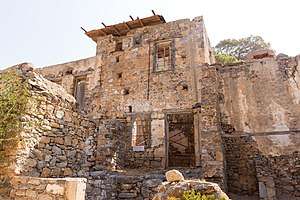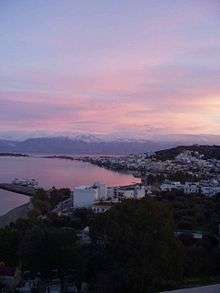Elounda
Get in
By plane
Flights are available to Heraklion Airport (HER IATA) near Heraklion (about 80 km (50 mi) away, 1 hour's drive) from many European countries and via Athens from elsewhere. Drive on E74 to Agios Nikolaos (70 km) and then turn for Elounda.
By bus
A local bus service with modern air conditioned buses is available. Take a bus to Agios Nikolaos and get connecting bus to Elounda.
By ferry
Major ferry lines operate to the port of Herakleion, connecting with bus services at the main bus station near to the port. Ferries run to the nearby town of [Agios Nikolaos] via LANE lines from Pireaus and Rhodes.
Get around
By car
Car rental is available.
By bus
Good and modern public transport is provided by the KTEL bus company.
By foot
Elounda is a cosmopolitan town/village with a small fishing port. It has several sandy beaches all in walking distance from the centre (square)
The square has many bars,restaurants and fast food businesses. You can even find a few kafenions here the real traditional watering holes.
Elounda's fishing port also offers boat trips to the nearby Island of Spinalonga (Kalidon) which in the past was used as a leper colony.
Near the main beach a little way from the square is a children's play area. There are shops, bars and restaurants close by. The beach has been awarded the blue flag.
Near to this beach there is also boat trips and one boat called the Shark's Eye has a glass bottom and is a hydrofoil.
If you walk back through the square to the other end..you will see a street going up a bank. You probably came down this street on your coach. On this street there are shops, bars, restaurants and Jewellery shops, Fashion shops, tourist shops, and even a couple of night clubs.
Going further up this street you will see a cut going down to the left. You will see a sign saying "Sanken City Of Olous"(yes sanken) This was the original Elounda many questions are being asked about this city "was Olous the real Atlantis from Myths and Legends ?" As you walk along the causeway you may still see some of the walls of the city in the water. Keep walking and you will come across a small beach, with a large old stone building at the end of it. This building was origanally built as a storage building. Keep walking along and to you right you will see some old windmills. Here is a beautiful spot over the bridge a small canal with fishing boats to the side. You will also see the original stone bridge now broken. This Canal was built by the French many many Years ago. There are many things to see this side of the bridge .......and if you are fit and can put up with the heat even a beautiful fine white sand beach.
See
Spinalonga Island

Spinalonga Island (Σπιναλόγκα) is the setting for the bestseller "The Island" by Victoria Hislop that was made into a popular television mini-series. The novel chronicles the history of the island as a leper colony through the lives of a family from Plaka. Spinalonga Island is easily accessed by boat from Agios Nikolaos, Elounda, and the small village of Plaka.
The island of Spinalonga (Καλυδών, Kalidon) has captured the imagination of many throughout its long history. Since millennia past, artists, musicians and authors have romanticised and written about this island. It is one of the most visited tourist attractions on Crete, and annually thousands of visitors walk along the narrow streets through the village on Spinalonga. The name 'Spinalonga,' which means 'Long Thorn,' came from the Venetians after a small island near Venice. The official name is Kalidon, but so well known is its former name that even the sign posts and the boats that take you to the island will call it only by its Venetian name.
Spinalonga is an island fortress on the southwestern entrance to the Gulf of Elounda. It is 5.6km away from Skisma (the central village of Elounda). On the rocky island of Spinalonga, a fortress was built even from ancient ages to protect the port of the ancient Eloundians. It is reported that many Christians from the surrounding village took refuge in the ruins to save themselves during the time that the Saracens overtook Crete.
In 1579, the Venetian rulers built the powerful fortress for the safety of the port of Elounda, enclosing the area from hostile ships. It was originally part of the mainland, but the Venetians undertook the engineering project of turning it into an island. In 1630, the fortress seemed to be impregnable but in 1715, the Kapoudan Pasha, the Turkish captain, besieged it at close quarters and took it. During the 1821 Revolution, it was a safe haven for many Turks, and during the 19th century it was the main port that was importing and exporting goods for the entire region of Mirabello. In 1881, it had 1112 Ottoman inhabitants who were involved in commerce, and they comprised the local council. During the revolution of 1821, 1866 and 1897, it was besieged by Cretan rebels.
By edict of the State of Crete, from 1904 Spinalonga was used as a gathering point and place of refuge for Cretans suffering from leprosy. After a couple decades, it became the home of those from all over Greece who were suffering from the disease. Before this time, lepers lived a harsh life as outcasts, many living in the caves that riddle Crete and other areas of Greece. Exile to Spinalonga was harsh, as many people were separated from their families on the mainland. But at least they had company. People fell in love, married, and had children. There was agriculture and farm animals and a school. Goods were brought daily from the mainland. It was one of the safest places to be during the Nazi occupation of the island. Nonetheless, life was difficult. Death from leprosy was often very painful, and a number of the exiles committed suicide by leaping into the sea from the high fortress walls. With the progress of science, a cure was found, and the hospital was closed in 1957 as those who were now cured returned to their homes around the country.
Practical Information The boat from Plaka takes only about ten minutes, and is reasonably priced. From Elounda or Agios Nikolaos, the boat ride is longer and more costly. During the season, boats depart from several locations in all three towns. If you are going late in the day, make sure you know when the last boat departs the island. Additionally, boarding a boat back to mainland is pretty informal. You can get on just about any of them. Make sure you know which town it is heading for, or you could end up miles from your car. As long as you are going back to the right town, it really doesn't matter which boat you get on. You may end up at a slightly different location than where you originally boarded, but the walk will not be far.
There is a nominal fee to enter the site, and you can purchase guide books in several languages when you pay for your ticket. You can spend an entire day exploring this fascinating place, but you should set aside at least two hours, plus the boat ride. During the heat of the summer, it is a good idea to try to go as early in the day as possible. Bring a bottle of water. There is a small taverna/cafe and public toilets at the landing area. You cannot picnic inside the site, but you can picnic outside the fortress walls around the landing area. To fully explore the entire island requires a great deal of walking, up inclines and up and down steep stairs. For those who cannot manage all this walking, the most interesting part of the island can be done quite easily without all the inclines and stairs. This area is the main part of what was the village, including the "main street" shops, many homes, and public buildings like the hospital and church.
There are many tavernas clustered around the embarkation/disembarkation areas in Plaka, Elounda, and Agios Nikolaos. The owners will actively invite you to have your lunch at theirs when you return. Don't feel pressured to go into the first one. Take a stroll to find the one that really appeals to you.
- Salt Pans 15th century salt evaporation pans which were still in use until the early 1970s.
- Canal Built by French engineers to ease trade between Elounda and Agios Nikolaos.
Do
- Elounda Village, Various. Visit the fishing village of Elounda. It is a cosmopolitan village with many shops and beautifully situated restaurants
Buy
The Shark's Eye Boat Tour.
The Eklektos bookshop for a diverse choice of literature, including those recommended by the helpful proprietor.
Visit the next village of Plaka on the Happy Train, which you can catch in the square. You can also take a trip to Spinalonga from Plaka.
Eat
- Ergospasio Restaurant, Elounda Main Road. The restaurant overlooks the beautiful Elounda bay and you can enjoy the view sitting on the waters edge. The food is fantastic with a matching wine selection.
- Lotus Eaters, On Sea-Front Road Near Causway. A beautiful family run taverna with excellent food and professional service and spectacular views.
Sleep

- Elounda Ilion Hotel Bungalows, ☎ +30 28410 41703, fax: +30 28410 41781, e-mail: info@elounda-ilion.com. 72053 Elounda. This hotel is built on a hill offering a panoramic view of the bay of Elounda.
- Selena Village Hotel (Plaka). 3 star hotel situated just opposite to the historical castle Spinalonga, over a marvelous and calm sea, 1.8 km from Elounda village
- Villa Marina (Plaka). It is built on a hillside overlooking Elounda gulf and the old Venetian island of Spinalonga. It is an villa in a large private ground with a superb sea view
- Elounda Villas. A haven of elegance, which blends in with the Elounda landscape overlooking the gulf of Mirabello. Here you can enjoy a cozy accommodation in a friendly environment.
- Anemos Villas Elounda. A collection of three luxury villas with swimming pool and sea view.
- Traditional Homes in Crete. 12 stone built traditional villas situated in the settlement of Mavrikiano - Elounda
- Elounda Palm Hotel (Main Road Heraklion-Elounda), ☎ +30 28410 41825. Check-in: 12:00, check-out: 12:00. Elounda Palm Hotel is built in atractive gardens with bungalows and suites that share a pool and offer magnificent panoramic sea views over the bay.
Splurge
- 🌍 Blue Palace Resort & Spa,, ☎ +30 28410 65500, fax: +30 28410 89712, e-mail: reservations@bluepalace.gr. Beautifully situated between the coast of Elounda and Spinalonga Island. Has 251 rooms including bungalows, suites and villas, some with private infinity pool. Five restaurants, including award winning L'Orangerie; spa, private beach, water sports and private boat.
- 🌍 Domes of Elounda All Suites and Villas Spa Resort, ☎ +30 28410 43500, fax: +30 28410 41603, e-mail: info@domesofelounda.com. 72053 Elounda,Crete,
- Aquila Elounda Village Hotel, ☎ +30 28410 41802, fax: +30 28410 41278, e-mail: info@aquilahotels.com. 208 elegant rooms, bungalows and suites.
